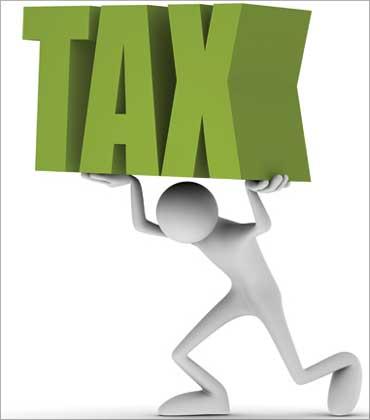 | « Back to article | Print this article |
A rush to save taxes can cost you dear
Come January and all we think of is tax saving for the year almost gone by.
To an extent, we are pushed by financial institutions which offer tax-saving and tax-free products.
Most fall for these and invest to save as much tax as possible.
However, financial advisors always say money should be deployed in accordance with your goals.
Click NEXT to read further. . .
A rush to save taxes can cost you dear
Financial planning anyway takes tax planning into consideration, says Aurangabad-based chartered accountant and financial planner Anirudha Hatwalne.
In fact, say financial planners, saving in line with future need will help you save more than if you do for just tax purposes.
Assume Person 1 plans to invest only to save taxes and Person 2 plans to invest in line with a clear financial plan.
Both are 30 years old, earn Rs 100,000 a month, spend Rs 40,000 every month, will retire at age 60 and will start investing from this year.
Person 1 plans to buy a house in five years, spend for his marriage two years later and save for retirement.
Click NEXT to read further. . .
A rush to save taxes can cost you dear
Person 2 plans an international vacation two years later, to buy a car and house in three and five years, respectively, and save for retirement.
To avoid taxes, Person 1 plans to invest Rs 100,000 to be able to cover the Section 80C mandate.
He will invest Rs 25,000 each in the Public Provident Fund and five-year fixed deposits, and Rs 50,000 in an endowment plan of an insurance company.
If he continues to invest in these instruments every year, he will earn an annual interest income of Rs 8,388 every year.
Click NEXT to read further. . .
A rush to save taxes can cost you dear
And, 10 years from now, he will have accumulated a total of Rs 14.3 lakh at a total of 8.39 per cent earned across all the three instruments every year (see Table 1).
| CHOICES DON'T COME EASY | |||
| TABLE 1 (Person 1) | |||
| Particulars | Details | Goals | Timeline |
| Age | 30 years | Buying a house | 5 years |
| Income | Rs 1 lakh a month | Marriage | 2 years |
| Expenses | Rs 40,000 | Retirement | 30 years |
| Investments | Returns (%) | Annual Interest Income (Rs ) | |
| PPF | Rs 25,000 | 880.00% | 2,200 |
| 5-year FD | Rs 25,000 | 8.75 | 2,188 |
| Endowment plan | Rs 50,000 | 8 | 4,000 |
| Total | Rs 1,00,000 | 8.39 | 8,388 |
| Total saving after 10 years: Rs 14.30 lakh | |||
| (Person 2) | |||
| Particulars | Details | Goals | Timeline |
| Age | 30 years | Vacation | 2 years |
| Income | Rs 1 lakh a month | Buying a car | 3 years |
| Expenses | Rs 40,000 | Buying a house | 5 years |
| Retirement | 30 years | ||
| Investments suggested as per goals | Returns (%) | Annual Interest Income (Rs ) | |
| PPF | Rs 25,000 | 8.8 | 2,200 |
| ELSS | Rs 25,000 | 11 | 2,750 |
| Ulips | Rs 50,000 | 10 | 5,000 |
| Total | Rs 1,00,000 | 9.95 | 9,950 |
| Total saving after 10 years Rs 16.20 lakh / OR | |||
| Equity diversified fund | Rs 97,400 | 10 | |
| Term plan | Rs 2,600 | - | |
| Total | Rs 1,00,000 | 10 | 9,740 |
| Total saving after 10 years: Rs 14.83 lakh | |||
By investing Rs 25,000 in PPF every year for next 10 years (total investment is Rs 250,000), Person 1 will earn Rs 159,000 as returns at 8.8 per cent, taking his total tax-free income to Rs 4,09000.
Similarly, on making a Rs 25,000 fixed deposit every year till next 10 years, Person 1 will earn Rs 360,000.
Remember, the interest income on tax-saving deposits is taxable.
Last, he earns Rs 660,000 from endowment plan where he invests Rs 50,000 every year and earns eight per cent annually.
Click NEXT to read further. . .
A rush to save taxes can cost you dear
Keeping in mind Person 2's goals, Hatwalne advises he invests Rs 100,000 across Public Provident Fund, equity-linked savings schemes and unit-linked insurance plans.
Or, Person 2 can divide his money between a term plan and equity diversified schemes.
"I advised Ulips because this product has more charges in the first year only.
"Like, the product I have taken here is Life Stage Wealth 2 from ICICI Prudential Life Insurance, which levies only Rs 2,000 in the first year.
In comparison, mutual funds levy a flat 2.25 per cent fund management fee each year, lowering the annual earning.
Then, for a long-term investor, Ulips will give a loyalty bonus towards the end of the policy term, which will take the maturity amount above that earned from mutual fund schemes," he says.
Click NEXT to read further. . .
A rush to save taxes can cost you dear
With investments in PPF, ELSS and Ulips, Person 2 will earn 9.95 per cent each year.
This means, he will have accumulated a total of Rs 16.2 lakh (Rs 1.62 million) at the end of 10 years.
And, if he sticks to a term plan and equity diversified plans, he will invest Rs 2,600 a year for a Rs 10 lakh (Rs 1 million) cover and the rest in equity diversified scheme(s).
As term plans are not an investment scheme, Person 2 will earn only from mutual fund investment.
After an annual return of 10 per cent minus a yearly charge of 2.25 per cent each year, Person 2 will make close to Rs 15 lakh (Rs 1.5 million), explains Hatwalne.
Click NEXT to read further. . .
A rush to save taxes can cost you dear
Similar to Person 1, Person 2 will also save Rs 409,000 through PPF.
For a return of 11 per cent, Person 2 will earn Rs 464,000 from ELSS after investing a total of Rs 250,000.
And, an investment of Rs 50,000 every year in Ulip will help him save Rs 750,000 at 10 per cent return every year.
If both Person 1 and Person 2 invest Rs 100,000 every year in the same instruments as mentioned above, they will save Rs 1.07 crore (Rs 10.7 million) and Rs 1.63 crore (Rs 16.3 million), respectively, for retirement.
Given they each want to buy a house, assume they get one costing Rs 60 lakh (Rs 6 million) with a loan of Rs 48 lakh (Rs 4.8 million) each, for 20 years.
Click NEXT to read further. . .
A rush to save taxes can cost you dear
And, if they start saving for retirement after 20 years, that is, in last 10 years of their service, they will save around Rs 67 lakh (Rs 6.7 million) each, says Hatwalne.
Investing only to save tax leads to making very bad investments as well.
"There is duplication of instruments chosen or unwanted investments are made in pursuit to save taxes.
"So, while saving taxes is an important aspect, overdoing it can actually do more damage to your finances," certified financial planner Suresh Sadagopan had earlier told Business Standard.
Click NEXT to read further. . .
A rush to save taxes can cost you dear
Take example of investments in insurance-cum-investment products, made blindly year after year by many to save taxes.
Investment in medical insurance and PPF are yet another example.
Salaried individuals, especially youngsters, could be better off investing in other instruments that give a return on their money than deploy in health insurance and PPF, as most of them have a group insurance to fall back on and the Employee Provident Fund kitty for retirement needs.
| TABLE 2 | |||
| Person 1 | Person 2 | ||
| PPF | PPF | ||
| Total contribution in 10 years | Rs 2.50 lakh | Total contribution in 10 years | Rs 2.50 lakh |
| Total interest income over 10 years | Rs 1.59 lakh | Total interest income over 10 years | Rs 1.59 lakh |
| Total saving after 10 years | Rs 4.09 lakh | Total saving after 10 years | Rs 4.09 lakh |
| Fixed Deposit | ELSS | ||
| Total contribution in 10 years | Rs 2.50 lakh | Total contribution in 10 years | Rs 2.50 lakh |
| Total interest income over 10 years | Rs 1.10 lakh | Total interest income over 10 years | Rs 2.14 lakh |
| Total saving after 10 years (net of tax) | Rs 3.60 lakh | Total saving after 10 years (net of tax) | Rs 4.64 lakh |
| Endowment plan | Ulip | ||
| Total contribution in 10 years | Rs 5 lakh | Total contribution in 10 years | Rs 5 lakh |
| Total interest income over 10 years | - | Total interest income over 10 years | - |
| Total saving after 10 years | Rs 6.60 lakh | Total saving after 10 years | Rs 7.50 lakh |
| Depends on interest rate cycle Depends on funds chosen, fund performance, ulip charges, bonus Compiled by CA & Financial Planner Anirudha Hatwalne | |||









